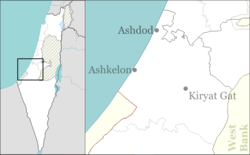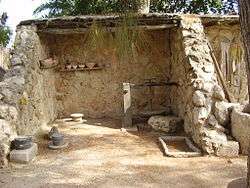Revadim
| Revadim | |
|---|---|
 Revadim | |
| Coordinates: 31°46′25.32″N 34°49′0.83″E / 31.7737000°N 34.8168972°ECoordinates: 31°46′25.32″N 34°49′0.83″E / 31.7737000°N 34.8168972°E | |
| District | Southern |
| Council | Yoav |
| Affiliation | Kibbutz Movement |
| Founded |
14 February 1947 (original) 28 November 1948 (current) |
| Founded by | Hashomer members |
| Population (2015) | 653[1] |
| Website | http://www.revadim.org.il |

Revadim (Hebrew: רְבָדִים) is a kibbutz in southern Israel. Located in the southern coastal plain, it falls under the jurisdiction of Yoav Regional Council. In 2015 it had a population of 653.
History
Revadim was originally founded on 14 February 1947 as the fourth settlement of the Etzion Bloc in the Hebron Hills. It was established by the Tsabar pioneering group on tracts of land purchased by the Jewish National Fund in Ein Abu Zeid and Shuweika.[2] While the land was being reclassified as musha'a, the group cleared 100 dunams, 70 in Ein Abu Zeid and 30 in Wadi Abu Nofal, where the JNF owned a tract of mafruz. Plans included the reclamation of 70 dunams in Wadi Abu Nofal and 150 in Dhahr al-Masatikh, which were acquired as part of a land exchange agreement.[2]
On 13 May 1948, the village was razed to the ground by the Arab Legion. Survivors were taken prisoner by Jordan. The kibbutz was re-established in a new location on 28 November 1948. The released POWs were joined by immigrants from Bulgaria and other countries.[3]
Economy
The economy is based on tourism and small industry. It operates a guest rooms and a museum of antiquities. The Roman Glass Co. designs original jewellery for a worldwide market.[4]
Landmarks
The kibbutz has a memorial for members who fell in the 1948 Arab–Israeli War. Tel Miqne-Ekron, an archaeological tell on the grounds of the kibbutz, is believed to be the site of the biblical city of Ekron.[5]A reconstructed Philistine street is open to visitors. The kibbutz operates the Ekron Museum of the History of Philistine Culture which displays finds from the excavations.[6]
Archaeology
Tel Miqne-Ekron is one of the largest Iron Age sites in Israel. Archaeologists have discovered over 100 oil presses there, as well as the Ekron Inscription, which identifies the site as Philistine Ekron. Tel Miqne (Khirbat al-Muqanna') dates to the 12th century BC. The city is mentioned in Joshua 13:2-3 and I Samuel 5:10 in relation to the Ark of the Covenant. After the arrival of the Philistines, one of the Sea Peoples, Ekron became a fortified urban center that supplied Egypt and the Assyrian empire with 700 tons of olive oil a year, making it the largest olive oil industrial center in the ancient Middle East. The reconstructed Philistine street features an oil press, a potters’ wheel and a loom, attesting to an active textile industry. [7]
Another archeological site at the Revadim region is at least 300 to 500 thousand years old (based on paleomagnetism analysis and uranium date series), and the archeological finds there belong to Late Acheulean. At the site numerous faunal remains were excavated, as well as some flint tools with fat residue, suggesting that the bones (including those of straight-tusked elephant) belong to butchered game.[8]
References
- ↑ "List of localities, in Alphabetical order" (PDF). Israel Central Bureau of Statistics. Retrieved 16 October 2016.
- 1 2 Yossi Katz Between Jerusalem and Hebron: Jewish Settlement in the Pre-State Period, pp.254–264.
- ↑ Revadim Jewish Virtual Library
- ↑ Roman Glass Company
- ↑ The Revadim seal and its archaic Phoenician inscription
- ↑ A Reconstructed Philistine Street
- ↑ A Reconstructed Philistine Street
- ↑ Solodenko, N.; Zupancic, A.; Cesaro, S. N.; Marder, O.; Lemorini, C.; Barkai, R. (March 18, 2015). "Fat Residue and Use-Wear Found on Acheulian Biface and Scraper Associated with Butchered Elephant Remains at the Site of Revadim, Israel". PLoS ONE. 10 (3). doi:10.1371/journal.pone.0118572. Retrieved 2015-03-07.